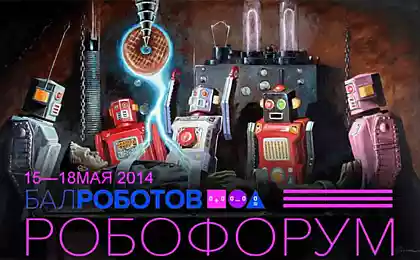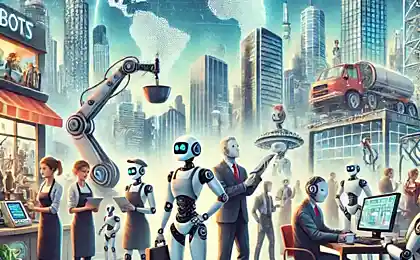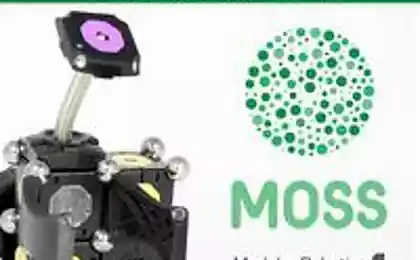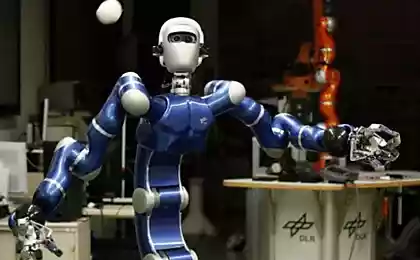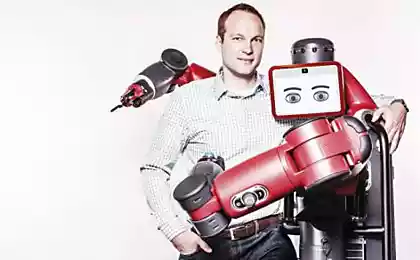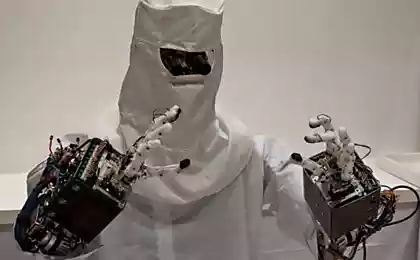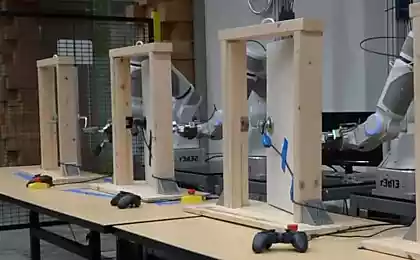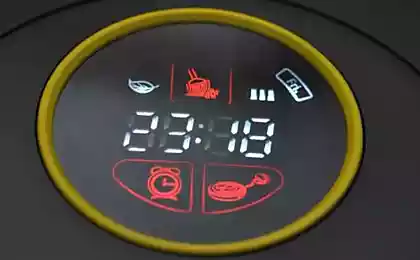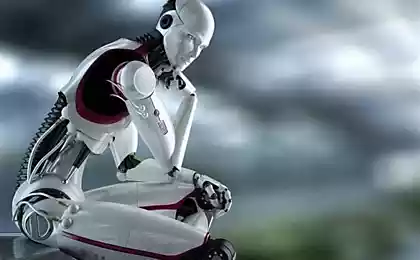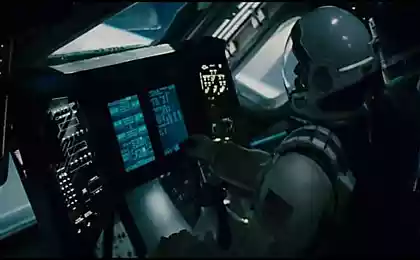630
Jobs for the future — learning robots interacting with people
Decades of sci-Fi movies have taught people to fear robots: they will enslave us, wipe us from the face of the Earth, take away our jobs.
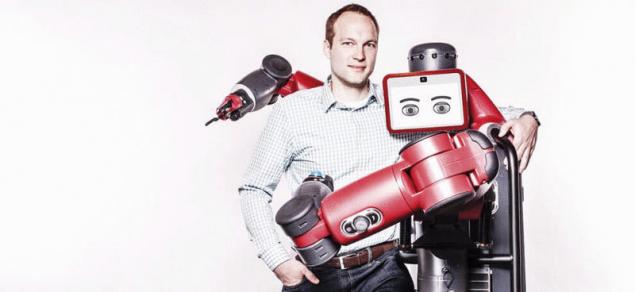
In real life people and machines learn to do more together than they could do separately. Below are six companies where the training robots is in full swing, and people receive valuable training in the field of technology.
AUTODESK
The robot learns to draw
In the new short film "Art Lover", the famous droid from the "Star wars" is going crazy in the dome-shaped mailbox. The film, written and directed by Autodesk engineer Evan Atherton, recalled the scene in which the lovers posing for a sketch that draws a robot. Not agreeing with the fakes Atherton asked my colleagues at Autodesk, David Tomasson, is it possible to teach the robot to draw sketches really. Why not? They taught the robot first to draw online, guiding his hand on the canvas, and in the end, his algorithm was able to take the process on themselves. Now the team is teaching the robot to paint and will use the motion capture technology that he could mimic and adapt human actions to create more original works. The hope, says Tomasson that robots will not only be "a practical tool, but also a creative partner."
RAYTHEON
Rapid and harmonious learning

One of the robots Raytheon, Tucson
The Raytheon plant in Tucson has an area of 47 000 square feet, and there's a lot of robots and people working together. Raytheon builds their robots: the company buys them and installs the shared software interface to make it easier to train them and reprogram. When the robot needs to learn something, the task is first simulated using a software of Raytheon, and then installed the robot for initial testing. The whole process, according to operator Charles Scott, may take from several hours to 1 day. After that, the model is updated and installed the robots that are being used.
This is the usual robots, but the guys made them focused on solutions for our products that are very complex, said Kim Ernzen, Vice President of operations. RETHINK ROBOTICS
Tricks is productivity

The robot Baxter from Nate Kuntz
Engineer Nate Kunz is a trainer robot Baxter from Rethink Robotics. Process it usually begins with a study of photographs or illustration of a task that the client (customers include – John Dery and Kaiser Permanente) wants to automate before you install Baxter on the Assembly line. Total training time may take from several hours to months, depending on complexity. Rethinking the problem often carries over to the Baxter learning new tricks, such as bartending or playing Connect Four. Games can push on new ideas for the software. One such solution comes from the employee who taught Baxter to make coffee. In the end, the process is used for quality control in the production of beverages. Baxter has been trained to mix the drink, examine the sediment and pour it like he was taught when making coffee.
GENERAL MOTORS
Approaching robotics
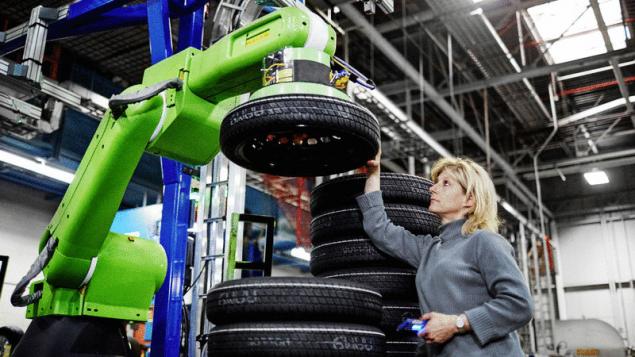
The robot is hard at work at the company's plant in Orion
Some unhappy people at GM plant in Orion, Michigan, was boring hard work: they removed the spare tire from the conveyor and stacked them, depending on what vehicle they were intended. Not surprisingly, the first collaborative robot, which appeared at the factory in January, was instructed to lay down tires. The most difficult was to teach him how to maneuver in a crowded workspace, where people, as a rule, are from each other at a distance less than one meter. "Manufacturing is a contact sport," says GM engineer Marty Linn. GM abandoned the sensitivity of the force sensors of the robots and went through a lot of rehearsals using real props and people. People had to learn to work with the robot, through "information week" of testing. The robot is now considered part of the team.
A. ZAHNER CO.
Performs welding work is not worse than a man

Bill Zahner and his robot
Architects all over the world turn to the company A. Zahner Co. from Kansas city for a huge steel structures and facades custom made that adorn buildings such as the Guggenheim Museum in new York, the Dallas Cowboys stadium and Art Wall at Doha. For many years factory workers Zahner reluctant to accept robots as collaborators and Director bill Zahner not understand that so they will release skilled craftsmen to perform more complex work on large-scale projects.
If you do some things faster, it allows you to develop more creative aspects, said Zahner. The first robot arrived in 2007 and started to study, watching as the engineers weld points on arcs of length up to 4.5 m. He followed the same points, based on the movements that showed the engineers. Welds made by the robot, were not worse than those that did master. Sahner notes that, perhaps even better, because the robots do not get tired by the end of a long day.
ABB ROBOTICS Simple as the iPhone

Robot Yumi (ABB)
New robot from ABB Robotics — YuMi is a two-handed employee for companies that have not previously used such technologies. Its user interface was inspired by the iPhone, presenting a "complex product, where the user does not need to know a lot," says engineer ABB Bertil, Thorvaldson. YuMi can be programmed for basic tasks, having only the app on the tablet, but now more advanced users use the full set of software tools for tasks such as manufacturing electronics. All the robots YuMi is likely the easiest to teach.published
P. S. And remember, only by changing their consumption — together we change the world! ©
Source: www.robo-hunter.com/news/rabota-budushego-obuchenie-robotov-vzaimodeistviy-s-lydmi

In real life people and machines learn to do more together than they could do separately. Below are six companies where the training robots is in full swing, and people receive valuable training in the field of technology.
AUTODESK
The robot learns to draw
In the new short film "Art Lover", the famous droid from the "Star wars" is going crazy in the dome-shaped mailbox. The film, written and directed by Autodesk engineer Evan Atherton, recalled the scene in which the lovers posing for a sketch that draws a robot. Not agreeing with the fakes Atherton asked my colleagues at Autodesk, David Tomasson, is it possible to teach the robot to draw sketches really. Why not? They taught the robot first to draw online, guiding his hand on the canvas, and in the end, his algorithm was able to take the process on themselves. Now the team is teaching the robot to paint and will use the motion capture technology that he could mimic and adapt human actions to create more original works. The hope, says Tomasson that robots will not only be "a practical tool, but also a creative partner."
RAYTHEON
Rapid and harmonious learning

One of the robots Raytheon, Tucson
The Raytheon plant in Tucson has an area of 47 000 square feet, and there's a lot of robots and people working together. Raytheon builds their robots: the company buys them and installs the shared software interface to make it easier to train them and reprogram. When the robot needs to learn something, the task is first simulated using a software of Raytheon, and then installed the robot for initial testing. The whole process, according to operator Charles Scott, may take from several hours to 1 day. After that, the model is updated and installed the robots that are being used.
This is the usual robots, but the guys made them focused on solutions for our products that are very complex, said Kim Ernzen, Vice President of operations. RETHINK ROBOTICS
Tricks is productivity

The robot Baxter from Nate Kuntz
Engineer Nate Kunz is a trainer robot Baxter from Rethink Robotics. Process it usually begins with a study of photographs or illustration of a task that the client (customers include – John Dery and Kaiser Permanente) wants to automate before you install Baxter on the Assembly line. Total training time may take from several hours to months, depending on complexity. Rethinking the problem often carries over to the Baxter learning new tricks, such as bartending or playing Connect Four. Games can push on new ideas for the software. One such solution comes from the employee who taught Baxter to make coffee. In the end, the process is used for quality control in the production of beverages. Baxter has been trained to mix the drink, examine the sediment and pour it like he was taught when making coffee.
GENERAL MOTORS
Approaching robotics

The robot is hard at work at the company's plant in Orion
Some unhappy people at GM plant in Orion, Michigan, was boring hard work: they removed the spare tire from the conveyor and stacked them, depending on what vehicle they were intended. Not surprisingly, the first collaborative robot, which appeared at the factory in January, was instructed to lay down tires. The most difficult was to teach him how to maneuver in a crowded workspace, where people, as a rule, are from each other at a distance less than one meter. "Manufacturing is a contact sport," says GM engineer Marty Linn. GM abandoned the sensitivity of the force sensors of the robots and went through a lot of rehearsals using real props and people. People had to learn to work with the robot, through "information week" of testing. The robot is now considered part of the team.
A. ZAHNER CO.
Performs welding work is not worse than a man

Bill Zahner and his robot
Architects all over the world turn to the company A. Zahner Co. from Kansas city for a huge steel structures and facades custom made that adorn buildings such as the Guggenheim Museum in new York, the Dallas Cowboys stadium and Art Wall at Doha. For many years factory workers Zahner reluctant to accept robots as collaborators and Director bill Zahner not understand that so they will release skilled craftsmen to perform more complex work on large-scale projects.
If you do some things faster, it allows you to develop more creative aspects, said Zahner. The first robot arrived in 2007 and started to study, watching as the engineers weld points on arcs of length up to 4.5 m. He followed the same points, based on the movements that showed the engineers. Welds made by the robot, were not worse than those that did master. Sahner notes that, perhaps even better, because the robots do not get tired by the end of a long day.
ABB ROBOTICS Simple as the iPhone

Robot Yumi (ABB)
New robot from ABB Robotics — YuMi is a two-handed employee for companies that have not previously used such technologies. Its user interface was inspired by the iPhone, presenting a "complex product, where the user does not need to know a lot," says engineer ABB Bertil, Thorvaldson. YuMi can be programmed for basic tasks, having only the app on the tablet, but now more advanced users use the full set of software tools for tasks such as manufacturing electronics. All the robots YuMi is likely the easiest to teach.published
P. S. And remember, only by changing their consumption — together we change the world! ©
Source: www.robo-hunter.com/news/rabota-budushego-obuchenie-robotov-vzaimodeistviy-s-lydmi
